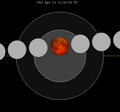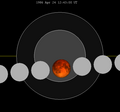April 2005 lunar eclipse
| Penumbral eclipse | |||||||||
 From Minneapolis, Minnesota, with inset images of a full moon a few hours before the eclipse, and the setting moon at 9:55 UT near greatest eclipse. | |||||||||
| Date | April 24, 2005 | ||||||||
|---|---|---|---|---|---|---|---|---|---|
| Gamma | −1.0885 | ||||||||
| Magnitude | −0.1417 | ||||||||
| Saros cycle | 141 (23 of 73) | ||||||||
| Penumbral | 245 minutes, 38 seconds | ||||||||
| |||||||||
A penumbral lunar eclipse occurred at the Moon’s descending node of orbit on Sunday, April 24, 2005,[1] with an umbral magnitude of −0.1417. A lunar eclipse occurs when the Moon moves into the Earth's shadow, causing the Moon to be darkened. A penumbral lunar eclipse occurs when part or all of the Moon's near side passes into the Earth's penumbra. Unlike a solar eclipse, which can only be viewed from a relatively small area of the world, a lunar eclipse may be viewed from anywhere on the night side of Earth. Occurring about 4.9 days before perigee (on April 29, 2005, at 6:10 UTC), the Moon's apparent diameter was larger.[2]
Visibility
[edit]The eclipse was completely visible much of western North America, the Pacific Ocean, and eastern Australia, seen rising over Australia and east Asia and setting over eastern North America and South America.[3]

|
 Hourly motion shown right to left |
 The Moon's hourly motion across the Earth's shadow in the constellation of Virgo. |
 Visibility map | ||
Images
[edit]
Eclipse details
[edit]Shown below is a table displaying details about this particular solar eclipse. It describes various parameters pertaining to this eclipse.[4]
| Parameter | Value |
|---|---|
| Penumbral Magnitude | 0.86693 |
| Umbral Magnitude | −0.14165 |
| Gamma | −1.08851 |
| Sun Right Ascension | 02h08m13.9s |
| Sun Declination | +12°57'36.8" |
| Sun Semi-Diameter | 15'54.1" |
| Sun Equatorial Horizontal Parallax | 08.7" |
| Moon Right Ascension | 14h06m23.1s |
| Moon Declination | -13°54'32.8" |
| Moon Semi-Diameter | 15'46.0" |
| Moon Equatorial Horizontal Parallax | 0°57'51.7" |
| ΔT | 64.7 s |
Eclipse season
[edit]This eclipse is part of an eclipse season, a period, roughly every six months, when eclipses occur. Only two (or occasionally three) eclipse seasons occur each year, and each season lasts about 35 days and repeats just short of six months (173 days) later; thus two full eclipse seasons always occur each year. Either two or three eclipses happen each eclipse season. In the sequence below, each eclipse is separated by a fortnight.
| April 8 Ascending node (new moon) |
April 24 Descending node (full moon) |
|---|---|
 |

|
| Hybrid solar eclipse Solar Saros 129 |
Penumbral lunar eclipse Lunar Saros 141 |
Related eclipses
[edit]Eclipses in 2005
[edit]- A hybrid solar eclipse on April 8.
- A penumbral lunar eclipse on April 24.
- An annular solar eclipse on October 3.
- A partial lunar eclipse on October 17.
Metonic
[edit]- Preceded by: Lunar eclipse of July 5, 2001
- Followed by: Lunar eclipse of February 9, 2009
Tzolkinex
[edit]- Preceded by: Lunar eclipse of March 13, 1998
- Followed by: Lunar eclipse of June 4, 2012
Half-Saros
[edit]- Preceded by: Solar eclipse of April 17, 1996
- Followed by: Solar eclipse of April 29, 2014
Tritos
[edit]- Preceded by: Lunar eclipse of May 25, 1994
- Followed by: Lunar eclipse of March 23, 2016
Lunar Saros 141
[edit]- Preceded by: Lunar eclipse of April 14, 1987
- Followed by: Lunar eclipse of May 5, 2023
Inex
[edit]- Preceded by: Lunar eclipse of May 13, 1976
- Followed by: Lunar eclipse of April 3, 2034
Triad
[edit]- Preceded by: Lunar eclipse of June 24, 1918
- Followed by: Lunar eclipse of February 23, 2092
Lunar eclipses of 2002–2005
[edit]| Lunar eclipse series sets from 2002–2005 | ||||||||
|---|---|---|---|---|---|---|---|---|
| Descending node | Ascending node | |||||||
| Saros Photo |
Date View |
Type Chart |
Gamma | Saros Photo |
Date View |
Type Chart |
Gamma | |
| 111 | 2002 May 26
|
penumbral
|
1.1759 | 116 | 2002 Nov 20
|
penumbral
|
−1.1127 | |
121
|
2003 May 16
|
total
|
0.4123 | 126
|
2003 Nov 09
|
total
|
−0.4319 | |
131
|
2004 May 04
|
total
|
−0.3132 | 136
|
2004 Oct 28
|
total
|
0.2846 | |
| 141 | 2005 Apr 24
|
penumbral
|
−1.0885 | 146
|
2005 Oct 17
|
partial
|
0.9796 | |
| Last set | 2002 Jun 24 | Last set | 2001 Dec 30 | |||||
| Next set | 2006 Mar 14 | Next set | 2006 Sep 07 | |||||
Saros 141
[edit]Lunar Saros 141, repeating every 18 years and 11 days, has a total of 72 lunar eclipse events including 26 total lunar eclipses.
First Penumbral Lunar Eclipse: 1608 Aug 25
First Partial Lunar Eclipse: 2041 May 16
First Total Lunar Eclipse: 2167 Aug 01
First Central Lunar Eclipse: 2221 Sep 02
Greatest Eclipse of the Lunar Saros 141: 2293 Oct 16
Last Central Lunar Eclipse: 2546 Mar 18
Last Total Lunar Eclipse: 2618 May 01
Last Partial Lunar Eclipse: 2744 Jul 16
Last Penumbral Lunar Eclipse: 2888 Oct 11
1901-2100
April 2005 lunar eclipse
Metonic series
[edit]This eclipse is the last of four Metonic cycle lunar eclipses on the same date, 23–24 April, each separated by 19 years:
The Metonic cycle repeats nearly exactly every 19 years and represents a Saros cycle plus one lunar year. Because it occurs on the same calendar date, the Earth's shadow will in nearly the same location relative to the background stars.
| Descending node | Ascending node | |||||
|---|---|---|---|---|---|---|
| Saros | Date | Type | Saros | Date | Type | |
| 111 | 1948 Apr 23 | Partial | 116 | 1948 Oct 18 | Penumbral | |

|

| |||||
| 121 | 1967 Apr 24 | Total | 126 | 1967 Oct 18 | Total | |

|

| |||||
| 131 | 1986 Apr 24 | Total | 136 | 1986 Oct 17 | Total | |

|

| |||||
| 141 | 2005 Apr 24 | Penumbral | 146 | 2005 Oct 17 | Partial | |

|

| |||||
Half-Saros cycle
[edit]A lunar eclipse will be preceded and followed by solar eclipses by 9 years and 5.5 days (a half saros).[5] This lunar eclipse is related to two solar eclipses of Solar Saros 148.
| April 17, 1996 | April 29, 2014 |
|---|---|

|

|
See also
[edit]- List of lunar eclipses and List of 21st-century lunar eclipses
- May 2003 lunar eclipse
- November 2003 lunar eclipse
- May 2004 lunar eclipse
- File:2005-04-24 Lunar Eclipse Sketch.gif Chart
References
[edit]- ^ "April 23–24, 2005 Penumbral Lunar Eclipse". timeanddate. Retrieved 13 November 2024.
- ^ "Moon Distances for London, United Kingdom, England". timeanddate. Retrieved 13 November 2024.
- ^ "Penumbral Lunar Eclipse of 2005 Apr 24" (PDF). NASA. Retrieved 13 November 2024.
- ^ "Penumbral Lunar Eclipse of 2005 Apr 24". EclipseWise.com. Retrieved 13 November 2024.
- ^ Mathematical Astronomy Morsels, Jean Meeus, p.110, Chapter 18, The half-saros
External links
[edit]- Saros cycle 141
- 2005 Apr 24 chart: Eclipse Predictions by Fred Espenak, NASA/GSFC
- Photo Archived 2016-03-07 at the Wayback Machine



